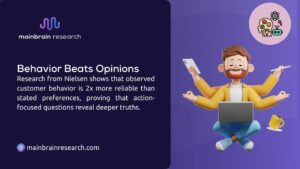When was the last time you got excited about filling out a survey? Probably never. And that’s exactly the problem most businesses have with their market research.
Companies throw money at research like crazy. We’re talking about a $140 billion industry here, but most of that cash gets wasted on questions that don’t tell you anything useful. You know the type – those surveys that ask “How satisfied are you with our service?” with a 1-10 scale that means absolutely nothing.
The worst part is that about 90% of new products still flop, and a lot of that comes down to companies asking the wrong questions or not asking any questions at all. Meanwhile, everyone’s doing online surveys (85% of researchers use them), but they’re asking stuff that makes people want to click away immediately.
61% of people are filling out surveys on their phones while they’re doing other things. They don’t have patience for your 47-question masterpiece about brand perception. They want to help, but only if you make it worth their time.
The companies that figure this out have a huge edge. They launch stuff people actually buy. They don’t waste months building features nobody wants. They know what to say in their marketing because they asked the right questions upfront.
But most businesses are still asking questions like it’s 1995, then wondering why their market research methods aren’t working.
What Makes People Answer Questions
Stop Being Nosy About Stuff That Doesn’t Matter
Asking for someone’s exact age, income, and life story before you even tell them what you’re trying to figure out. Would you answer that? Of course not.
Smart companies flip this around. They start with the interesting stuff and only ask personal questions that actually matter for what they’re trying to learn. If you’re selling business software, you care about company size and industry. If you’re selling running shoes, you care about how often someone exercises.
The trick is asking demographic questions that feel relevant instead of invasive. Instead of “What’s your household income?” try “How much do you typically spend on [your product category] per month?”
For B2B stuff, this might mean asking about team size instead of exact employee count, or decision-making role instead of job title. For consumer brands, lifestyle questions often work better than demographic boxes.
Companies doing serious quantitative market research need this demographic stuff to spot patterns, but only if people actually answer honestly instead of making something up to get through your survey.
Ask About Real Problems, Not Hypothetical Nonsense
This is where most product research goes off the rails. Companies ask things like “Would you use a feature that does X?” or “How important is Y to you?” These questions live in fantasy land.
Better questions focus on what people actually do, not what they think they might do someday. Instead of “Would you pay for premium features?” ask “What’s the biggest hassle with your current solution?” Instead of “How important is speed?” ask “Tell me about the last time something took too long”.
The best product insights come from understanding real situations, not hypothetical ones. What problem were they trying to solve when they found you? What happens when your thing breaks or doesn’t work? How does it fit into their actual routine?
Companies using primary market research for product development often get their best ideas from these reality-based questions. Customers use products in weird ways that nobody expected, and that’s where the good stuff happens.
Find Out About Competition Without Being Obvious
The sneaky way to do this is asking about decision-making instead of specific brands. What matters most when someone’s trying to solve this problem? Where do they go to research solutions? What would make them dump their current provider and try something new?
Sometimes the most interesting competitive insights come from asking about alternatives that aren’t direct competitors. If your product didn’t exist, what would people do instead? Sometimes it’s a competitor, sometimes it’s a totally different approach, sometimes it’s just living with the problem.
You can back this up with secondary market research to get the industry overview, but the real gold comes from understanding how real people actually make these decisions.
Question Types That Don’t Make People Want to Quit
Multiple choice seems easy until you realize how many ways you can screw it up. The main thing is giving people options that actually reflect how they think, not just how you think.
Good multiple choice questions always include “Other” with a text box. This is where you find out about stuff you never thought of. Pay attention to those “Other” responses – they often point to opportunities you’re missing.
Common mistakes: too many choices (people give up), overlapping choices (people get confused), or choices that don’t really cover the important options (people pick randomly). Keep it simple and make sure each choice is actually different.
Open-Ended Questions
Some researchers avoid open-ended questions because they’re harder to analyze, but that’s exactly why they’re valuable. This is where people tell you stuff you never thought to ask about.
The key is being specific about what you want. Instead of “Tell us what you think,” try “Walk me through what happened the last time you had to [solve this problem].” Specific prompts get specific, useful answers.
Don’t go crazy with these though. People hate typing long answers on their phones, and you’ll get more gibberish than insights if you overdo it. Use them strategically when you really need the story.
Rating Scales
Rating scales can work, but generic satisfaction ratings are pretty much useless. Instead of “How satisfied are you?” ask “How likely are you to recommend this to someone dealing with the same problem?”
Better yet, ask about specific things instead of overall impressions. Instead of rating “customer service” generally, ask about response time, helpfulness, and problem resolution separately. Now you know what to fix.
Keep the scale simple – 1-5 works better than 1-10 for most things because people can actually tell the difference between the options. And always explain what the numbers mean instead of assuming people know.
| Question Type | Good For | Don’t Do This |
| Multiple Choice | Quick preferences, categorizing | 15 options that all sound the same |
| Open-Ended | Getting the real story | “Please share your thoughts” (too vague) |
| Rating Scales | Comparing specific aspects | “Rate your overall experience” (useless) |
| Yes/No | Simple screening | Forcing complex issues into binary choices |
Making Research Work for Your Company
-
Start with Specific Goals
Every research project should answer a specific business question. Not “understand customers better” but “figure out which of these three features would increase retention most” or “find the price point that maximizes revenue for this new service.”
Vague goals lead to vague research, which leads to data you can’t use. Be brutally specific about what you need to know and why it matters for your business decisions.
Research can’t solve every problem. Sometimes you need to make decisions with incomplete information. Focus your research on questions where better data will actually change what you do.
Get Enough Good Responses
Sample size matters, but it’s not just about big numbers. You need enough responses from the right people to draw conclusions that matter. 100 responses from your target customers beats 1000 random responses from people who would never buy your stuff.
Think about how confident you need to be for different decisions. Major product launches might need extensive research. Minor feature tweaks might just need enough data to point you in the right direction.
Quality beats quantity every time. Better to get thoughtful responses from fewer people than rushed responses from many. Make it easy and worthwhile for the right people to participate.
-
Do Something with What You Learn
This seems obvious but tons of companies collect research data and then ignore it when making decisions. Research only helps if it changes what you do.
Share findings in ways that busy people can actually use. Nobody reads 50-page reports. Clear summaries with specific recommendations get attention and drive action.
Track how research insights influence decisions and outcomes. This helps justify spending money on research and improves how you do it over time. Companies that can show clear ROI from research tend to do more and better research as they grow.
The importance of market research becomes obvious when you see how good questions lead to better decisions, which lead to better results. But it only works if you actually use what you learn.
Stop Guessing About What Your Customers Want
MainBrain Research spent years figuring out what works and what’s a waste of time.
We help you figure out what questions will actually move your business forward. Whether you’re trying to understand why people aren’t buying, what features matter most, or how to price something new, we’ll help you get answers that matter.
For More:



















